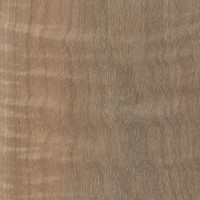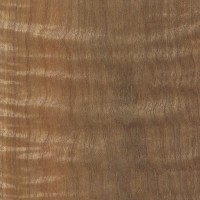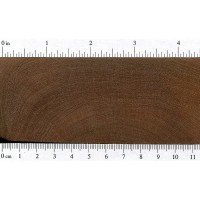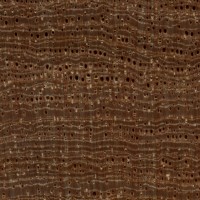 |
Common Name(s): Pyinma, Asian Satinwood, Crepe Myrtle Scientific Name: Lagerstroemia spp. Distribution: Southeast Asia Tree Size: 40-65 ft (12-20 m) tall, 2-3 ft (.6-1 m) trunk diameter Average Dried Weight: 44 lbs/ft3 (705 kg/m3) Specific Gravity (Basic, 12% MC): .55, .71 Janka Hardness: 1,090 lbf (4,850 N) Modulus of Rupture: 14,120 lbf/in2 (97.4 MPa) Elastic Modulus: 1,566,000 lbf/in2 (10.8 GPa) Crushing Strength: 9,300 lbf/in2 (64.1 MPa) Shrinkage: Radial: 4.4%, Tangential: 6.8%, Volumetric: 12.7%, T/R Ratio: 1.5 |
Color/Appearance: Heartwood typically golden to reddish brown, with paler yellow/gray sapwood. Colors tend to darken with age upon exposure to light. Curly grain figure very common in this species, with some pieces exhibiting outstanding curl.
Grain/Texture: Grain is usually straight, though some pieces have wavy or interlocked grain; texture is moderately coarse and uneven; good natural luster.
Endgrain: Ring-porous or semi-ring-porous; medium to large earlywood pores arranged in intermittent tangential rows with medium latewood pores, few; solitary and radial multiples of 2-3; tyloses common; narrow rays not visible without lens, spacing close to extremely close; parenchyma banded and marginal.
Rot Resistance: Rated as moderately durable to durable regarding decay resistance, with intermediate resistance to insect attack.
Workability: Generally easy to work, producing good results, though pieces with curly grain (as with any species of figured wood) will be inevitably more difficult to plane and machine without tearout. Doesn’t have the blunting effect on cutters that true satinwoods exhibit. Turns, glues, and finishes well—polishes to a high luster.
Odor: No characteristic odor.
Allergies/Toxicity: Besides the standard health risks associated with any type of wood dust, no further health reactions have been associated with Pyinma. See the articles Wood Allergies and Toxicity and Wood Dust Safety for more information.
Pricing/Availability: Prices are generally moderate for an imported wood. Pieces exhibiting an exceptional amount of figure may be more expensive, but Pyinma is generally priced very reasonably, even for figured wood.
Sustainability: This wood species is not listed in the CITES Appendices or on the IUCN Red List of Threatened Species.
Common Uses: Furniture, boatbuilding, general utility work (within its native range), turned objects, and other small specialty items.
Comments: It’s hard to tell if the wood is being selectively imported on account of its figure, or if the tree naturally produces a high percentage of curly figure, but from a wood buyer’s perspective, Pyinma is perhaps the curliest wood around. Nearly every piece shows some measure of curly grain, with some pieces having an almost three dimensional look on account of the heavy curl.
Unfortunately, Pyinma is being widely marketed today as “satinwood,” (or perhaps under slightly less confusing terms, such as “Asian satinwood,” or “Cambodian satinwood.”) Yet with the exception of it’s fantastic figure, Pyinma has little in common with the wood species that have been traditionally called satinwood, (it’s softer, lighter in weight, darker in color, much more porous, and of a coarser texture). But misnomers aside, Pyinma is still a great wood for many fine woodworking projects.
Related species of Pyinma, such as Lagerstroemia indica, are commonly sold as ornamental trees, and are referred to as Crepe Myrtle.
None available.





I have several pieces salvaged after a tornado. One is becoming a very intricatly carved walking staff and have also made a mallet for leather stamping. The mallet has held up very well. Great density for carving and very beautiful looking wood as well. Similar look to a polished tigers eye.
Is this the same species as Pride of India?
Yes and no. Pride of India is a particular species of Lagerstroemia (L. speciosa), while the wood that’s traded under the name pyinma could be any number of different Lagerstroemia species.
I made a couple of guitar picks from a large Natchez crape myrtle in my yard. When I wear them out I will definitely make more, one of the best picks for acoustic volume and sustain I’ve ever played. Will make a cheap laminate body guitar sound much better, makes my old Martin D-18 sound like an angel. Works well for bass and electric guitars as well. Very easy to work with once the wood has thoroughly dried.
I’ve got logs upon logs of the stuff here in Taiwan. We call it “monkey is afraid to climb” or sometimes “9 bows tree”. Evidently monkeys won’t climb it due to its slippery bark. It makes a good bow, so maybe that is where the other name comes from. I’ve seen it get to truly monstrous sizes in the wild and I do mean monstrous because it looks like living dinosaurs or something out of a sci-fi book when it gets that huge. I’ve seen one larger than three people could wrap their arms around and was full of pockets… Read more »
I have a bunch of the trees on the property, most thin and fairly useless, but I did harvest a few thicker trunks, but still haven’t found a way to keep them from splitting when drying.
The few pieces I’ve salvaged and dried have turned out to be wonderful pieces for tool handles and such..very hard and durable. It’s not the easiest wood in the world to plane, but once planed it produces a very smooth, hard and shiny surface. I’m thinking of making a few hand planes with the wood. Anyone have experience with crepe as plane material?
By the way Quiara, it’s among my most misspelled words. I try to remember the correct spelling, but you know..My 60 year old brain ain’t what it used to be.
Martino, if you are leaving the trunk as a whole round, it will split nearly every time, virtually regardless of the species of wood based on the internal stresses within the wood. Best to at least pre-split (or saw) the wood down the middle into half-rounds and use it that way. Or if you are making slabs, you can see this: https://www.wood-database.com/wood-articles/drying-wood-at-home/
I have found that removing the bark and dipping the ends in hot wax then drying them indoors in a closet works to keep small pieces from splitting.
I have one unusually large trunk of crepe myrtle that was cut almost 9 months ago. It has dried in one solid piece but has undergone the elements. I cut the trunk into two smaller pieces i intended to use a furniture. It is extremely hard and heavy. While sanding today it started to reveal green and darker striations. I believe the wood is still wet but doesn’t seem to have penetrated the inner layers because they look very light in color and dry. I am wondering how to proceed after reading a few posts on this site as well… Read more »
I would seal the ends, bigger knots and any large cuts then let it continue to season inside. You said you are “sanding it”? I would try scraping it. You will go through a lot of sandpaper if you are sanding bark. I think the green tinted part is bark and there my be a layer of dark rusty brown there too. All that will go away and reveil a creamy looking wood. If you had left the piece whole and flipped it over you would have had a wonderful table base where cracks and splits would have just added… Read more »
Thanks for your response. I am scrapping it now which became evident 5 minutes into my sanding ideas. The first tall pedestal piece is sealed and i am attaching a thin marble slab to the top. What an interesting wood and beautiful creamy color as you mentioned. I understand your suggestion to flip the piece to respect the nature of this wood when cut. I will use the additional pieces in that manner. I did not do my research prior to cutting.
Wonderful for walking sticks
We have several on the property and they grow very fast initially, but trunks seem a bit slower to develop and seldom grow straight once developed. I’m very interested in taking a few thicker pieces to build things with, but it’ll be awhile waiting for them to get big enough to do much with without sacrificing the few show trees in the yard. Most are more like weeds.
As a southerner who has many crepe myrtle on her property, not all of us don’t realize that “crepe” is pronounced “crape” – but that one of them isn’t an actual word.
Hi. I live south of the border (Mason-Dixon line) as well, am in the the landscape design business, and this drives me crazy. Even our regional wholesale nurseries have quit fighting it and print “Crape Myrtle” in their marketing stuff. I don’t see the problem. It stands for Crepe, as in the ruffled paper material, which the tree’s flower looks like, exactly. Maybe everybody was absent that day. BTW, around here every other maintenance company over prunes this tree. they make their cuts wherever they can while standing on the ground. God forbid they may have to get on a… Read more »
This is related to Lagerstroemia indica, also known as the common crepe myrtle. The common garden plant, while not large enough to produce lumber, can produce some very nice, hard, and stiff wood for canes, walking sticks and small turnings. It works well, has decent hardness and a nice white appearance when harvested from the smaller varieties.
Used this wood Pyinma for a pen blank.
The wood is a bit soft but easy to finish.
No blow outs of the wood when turning.
Very fine and light figuring and a bit of satiny shine.
Very enjoyable working with this wood.